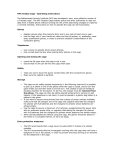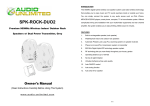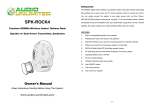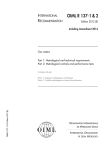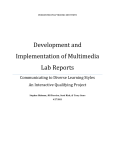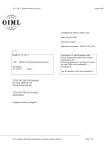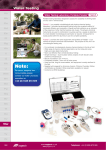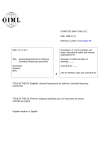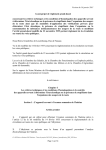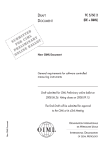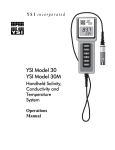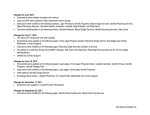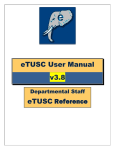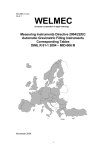Download OIML R 126 - Organisation Internationale de Métrologie Légale
Transcript
INTERNATIONAL RECOMMENDATION OIML R 126 Edition 1998 (E) Evidential breath analyzers OIML R 126 Edition 1998 (E) Éthylomètres ORGANISATION INTERNATIONALE DE MÉTROLOGIE LÉGALE INTERNATIONAL ORGANIZATION OF LEGAL METROLOGY OIML R 126: 1998 (E) Contents Foreword ........................................................................................................................................................................................... 3 1 Scope ............................................................................................................................................................................................. 4 2 Applications .................................................................................................................................................................................. 4 3 Terminology .................................................................................................................................................................................. 4 4 Units of measurement .................................................................................................................................................................. 5 5 Metrological requirements ........................................................................................................................................................... 5 6 Technical requirements ................................................................................................................................................................ 7 7 Practical instructions ................................................................................................................................................................. 10 8 Metrological controls ................................................................................................................................................................. 10 9 Test method ................................................................................................................................................................................ 11 Annex A Influence of variations of the parameters which characterize the test gases......................................................... 14 Annex B Physical influence factors .......................................................................................................................................... 15 Annex C Physiological influence factors.................................................................................................................................. 17 Annex D Physical disturbances ................................................................................................................................................ 18 Annex E Test report format ..................................................................................................................................................... 22 Annex F Evolution of concentration with time ...................................................................................................................... 31 Annex G General example of an apparatus for testing evidential breath analyzers ............................................................. 33 Annex H Test simulating the presence of ethanol in the upper respiratory tracts ............................................................... 37 Annex I Measuring cycle ......................................................................................................................................................... 38 2 OIML R 126: 1998 (E) Foreword T he International Organization of Legal Metrology (OIML) is a worldwide, intergovernmental organization whose primary aim is to harmonize the regulations and metrological controls applied by the national metrological services, or related organizations, of its Member States. Cooperative agreements are established between OIML and certain institutions, such as ISO and IEC, with the objective of avoiding contradictory requirements; consequently, manufacturers and users of measuring instruments, test laboratories, etc. may apply simultaneously OIML publications and those of other institutions. The two main categories of OIML publications are: International Recommendations and International Documents are published in French (F) and English (E) and are subject to periodic revision. • International Recommendations (OIML R), which are model regulations that establish the metrological characteristics required of certain measuring instruments and which specify methods and equipment for checking their conformity; the OIML Member States shall implement these Recommendations to the greatest possible extent; • International Documents (OIML D), which are informative in nature and intended to improve the work of the metrological services. OIML Draft Recommendations and Documents are developed by technical committees or subcommittees which are formed by the Member States. Certain international and regional institutions also participate on a consultation basis. This publication - reference OIML R 126, edition 1998 (E) was developed by the OIML subcommittee TC 17/SC 7 Breath Testers. It was approved for final publication by the International Committee of Legal Metrology in 1997, and will be submitted to the International Conference of Legal Metrology in 2000 for formal sanction. OIML publications may be obtained from the Organization’s headquarters: Bureau International de Métrologie Légale 11, rue Turgot - 75009 Paris - France Telephone: 33 (0)1 48 78 12 82 and 42 85 27 11 Fax: 33 (0)1 42 82 17 27 E-mail: [email protected] 3 OIML R 126: 1998 (E) Evidential breath analyzers 1 Scope 1.1 This International Recommendation applies to evidential breath analyzers (hereafter referred to as EBA’s) which are instruments that automatically measure the mass concentration of alcohol in exhaled breath. However, for the purpose of this Recommendation, only ethanol is considered as alcohol. In fact, physiological phenomena associated with alcohol and, in particular, the definition of that which constitutes the offence of driving (or working, etc.) under the influence of alcohol are not within the scope of this Recommendation. Likewise the legal definition of which compounds (methanol, ethanol, propanol, etc.) constitute alcohol is not provided in this Recommendation, such considerations being established by the responsible authorities of each country. 1.2 This Recommendation does not apply to screening devices which only detect ethanol without providing a sufficiently accurate measurement (see 2.2). 1.3 The performance requirements given here apply to EBA’s using currently available technology. This is not intended to restrict technical development nor exclude the use of other technologies as a means for analysis. 2.2 Screening devices are not generally used for establishing proof of driving under the influence of alcohol but are used as detectors of alcohol in the breath. 3 Terminology 3.1 Evidential breath analyzer (EBA) An instrument which measures the mass concentration of ethanol by analyzing deep lung air, usable for evidential purposes. 3.2 Non-portable evidential breath analyzer An EBA intended only for use within buildings or places providing similar environmental conditions. Note: The use of non-portable EBA’s in mobile laboratories may be considered, providing adapted conditions of transport are assured. 3.3 Portable evidential breath analyzer An EBA that may be used within or outside a building. 3.4 Deep lung air 1.4 National authorities may require EBA’s to include a specific conversion device that converts the measurement result obtained in terms of ethanol content in the exhaled breath at the measuring conditions either into physiological conditions or in terms of other quantities. This Recommendation does not cover the metrological performance of such devices. Breath delivered from the mouth of a subject that originates from the alveoli of the lungs, normally referred to as end-expiratory breath. 1.5 The purpose of this Recommendation is to define the performance requirements of EBA’s and the means and methods employed in testing them. 3.6 2 3.7 Applications 2.1 EBA’s can be used to measure accurately and display numerically the breath alcohol mass concentration of persons (drivers, workers, etc.) who may have consumed alcohol. 4 3.5 Alveolar air Air contained in the pulmonary alveoli. Normal operation The mode of usage which corresponds to the program of operations specified for EBA’s in service. Stand-by mode The mode of the EBA in which only certain circuits are energized in order to conserve power and/or prolong component life, and to attain the measuring mode more rapidly than would be possible if starting from the un-powered state. OIML R 126: 1998 (E) 3.8 Measuring mode The clearly marked mode in which the EBA can make measurements at the rate normally expected in service and in which it shall meet the performance requirements of this Recommendation. Note: The measuring mode and the stand-by mode (3.7) are modes of normal operation (3.6). 3.9 Device for adjustment to a standard A device for adjusting the EBA using, as a standard, a mixture of gases having a relative humidity of at least 90 % and a temperature of 34 °C ± 1 °C(*). The mixture of air and ethanol passes through the entire gas analysis train, starting with the mouthpiece, in the direction normally taken by exhaled air. Note: Adjustment using a dry gas is possible provided that the difference of effect between wet and dry gases is known or can be automatically corrected. 3.10 Device for adjustment by simulation A device for adjusting the EBA by a procedure other than that specified in 3.9, notably by the simulation of the effects of the passage of a standard mixture of gases as described in 3.9. 3.11 Adjustment-checking operation An operation involving all relevant internal elements which verifies that the EBA is suitably adjusted. 3.12 Drift The change in the indication which occurs during a stated period of time at a given mass concentration of ethanol in air. 3.13 Memory (residual) effect The difference between the indications obtained with two inputs of gas of a given mass concentration, a gas of a specified higher mass concentration being injected between these two inputs. (*) This ± 1 °C tolerance does not correspond to the uncertainty when preparing calibration gases (which is usually of 0.1 °C); it is the tolerance on the nominal temperature of calibration gases in use. 4 Physical quantities and units of measurement EBA’s shall be capable of expressing measurement results in terms of ethanol content in the exhaled breath at measuring conditions, for example mass concentration of ethanol per unit volume. In this Recommendation, the unit of measurement used is the milligram (of ethanol) per litre (of exhaled breath), mg/L. 5 Metrological requirements The requirements of clause 5 are applicable to individual measurements and not to any combination of measurements of a measuring cycle. 5.1 Maximum permissible errors 5.1.1 Maximum permissible errors for pattern evaluation and initial verification The maximum permissible errors, positive or negative, on each indication shall be: • 0.020 mg/L for all mass concentrations less than 0.400 mg/L; • 5 % of the measured concentration for all mass concentrations greater than or equal to 0.400 mg/L and less than or equal to 2.000 mg/L; • 20 % of the measured concentration for all mass concentrations greater than 2.000 mg/L. 5.1.2 Maximum permissible errors for EBA’s in service The recommended values of maximum permissible errors, positive or negative, on each indication for EBA’s in service are: • 0.032 mg/L for all mass concentrations less than 0.400 mg/L; • 8 % of the measured concentration for all mass concentrations greater than or equal to 0.400 mg/L and less than or equal to 2.000 mg/L; • 30 % of the measured concentration for all mass concentrations greater than 2.000 mg/L. 5.1.3 Rounding When comparing the error of an EBA with the corresponding maximum permissible error, this mpe shall 5 OIML R 126: 1998 (E) be rounded to the value of the verification scale interval. The error of a reading indicated by an EBA may be greater than the mpe by one verification scale interval. 5.2 Repeatability 5.2.1 Estimation of the standard deviation An estimate of the standard deviation is given by the formula: ABBB n s= Σ –2 (Yi – Y) i=1 n–1 5.3.2 Drift at 0.40 mg/L 5.3.2.1 Short-term drift The drift at 0.40 mg/L shall be less than 0.010 mg/L in 4 h. 5.3.2.2 Long-term drift The drift at 0.40 mg/L shall be less than 0.020 mg/L in 2 months. 5.4 Memory and residual effect 5.4.1 Memory effect The memory effect shall be less than 4 % in relative value, when the test is conducted according to 9.5.1. where: 5.4.2 Small changes in mass concentration n = the number of measurements made at a given mass concentration; Yi = the ith indication (out of n) of the EBA for that mass concentration; – Y = the arithmetic mean of the n values. The error in the result obtained with a gas having a mass concentration which is 0.10 mg/L less than that of another gas previously injected shall be less than the maximum permissible error for the lower mass concentration. 5.2.2 Requirements 5.5 The standard deviation for all mass concentrations less than 0.400 mg/L shall be less than 0.007 mg/L. When tested, the EBA shall meet the requirements with regard to the following influence quantities. The relative standard deviation for all mass concentrations greater than or equal to 0.400 mg/L and less than or equal to 2.000 mg/L shall be less than 1.75 %. 5.5.1 Influence factors in the parameters which characterize the test gases The relative standard deviation for all mass concentrations greater than 2.000 mg/L shall be less than 6 %. 5.2.3 Probability of compliance The statistical probability that the EBA satisfies the requirements of 5.2.2 shall be no less than 95 % for each mass concentration. For 20 measurements, for example, this provision would lead to EBA’s being refused with an estimation of the standard deviation greater than 1.26 times the maximum permissible standard deviation. 5.3 Drift 5.3.1 Zero drift The zero drift shall be less than 0.010 mg/L in 4 h. 6 Influence quantities The test methods and factor values are given in Annex A. a) Concerning the influence of: • delivered volume, • duration of exhalation, • duration of plateau, and • carbon dioxide, the errors in the results shall not exceed the maximum permissible errors stated in 5.1.1. b) Concerning the influence of interruption in the flow of breath, the EBA shall not give a result. c) Concerning the influence of ethanol in the upper respiratory tract, the national authorities may either decide that the instrument give no result, or else establish provisions concerning the use of the OIML R 126: 1998 (E) EBA (for example, a label stating “Wait at least xx minutes if the subject has drunk alcohol recently”). the methods for testing the EBA, the values of disturbances and the requirements are given in Annex D. 5.5.2 Physical influence factors Concerning the following physical influence factors: 5.6 • AC supply voltage, • supply frequency, • DC supply voltage, • ripple on DC voltage, • ambient temperature, • ambient relative humidity, • atmospheric pressure, and • quantity of hydrocarbons in the environment, the methods for testing the EBA, the values of factors and the requirements are given in Annex B. After the EBA has been subjected to a durability test as described in 9.6, the errors in the results shall be less than the maximum permissible errors specified in 5.1.2. 5.5.3 Physiological influence factors Constituent parts of medicines or the products of abnormal human metabolic substances contained in solvents or industrial products, or other gases may influence the result of the measurement if present in the breath. Annex C gives the list of interfering substances (with nominal values and maximum influences) with which EBA’s shall be tested in order to verify that they meet the requirements of this Recommendation concerning physiological influence factors. Durability 6 Technical requirements 6.1 Measurement range EBA’s shall be capable of measuring all mass concentrations in the range 0.00 mg/L to at least 1.50 mg/L. In normal operation, however, the EBA may indicate 0.00 mg/L for mass concentrations equal to or smaller than 0.05 mg/L. The greatest permissible value for the upper limit of the measurement range is 3.00 mg/L. 6.2 Scale interval The scale interval is 0.01 mg/L (scale interval of the EBA’s indication) in normal operation. During metrological testing or manual calibration it shall be possible to discriminate to 0.001 mg/L (verification scale interval of the EBA). 5.5.4 Physical disturbances Concerning the following physical disturbances: • short-time power reduction, • parasitic voltages on the mains, • vibrations resulting from normal conditions of transport or those corresponding to a stationary vehicle with the engine idling, • mechanical shocks resulting from normal handling conditions, • electrostatic discharges, • electromagnetic fields, • magnetic fields, • damp heat, cyclic (for portable EBA’s only), • ambient storage conditions (for portable EBA’s only), • shaking resulting from normal conditions of transport (for portable EBA’s only), and • disturbances for portable EBA’s used in the open air only, 6.3 Display 6.3.1 The result of a measurement shall be displayed digitally by means of aligned figures. The display in normal operation shall consist of the display in metrological testing (to 0.001 mg/L) rounded down to 0.01 mg/L (e.g. a measured value of 0.427 mg/L shall be displayed as 0.42 mg/L in normal operation). 6.3.2 The height of the figures shall be equal to at least: • 5 mm for fluorescent registering devices or devices having a luminosity recognized as equivalent; • 10 mm in all other cases. 6.3.3 The name of the unit of measurement or its symbol shall appear in close proximity to the figures indicating the result, and the characters used shall be at least 3 mm in height. 7 OIML R 126: 1998 (E) 6.4 Printing device EBA’s may be equipped with printing devices which print: • the result of the measurement. In normal operation, the printed result shall not differ from that which is indicated by any other indicating device(s); • the symbol of the unit in which the result is expressed. If the symbol of the unit is preprinted, the paper shall be specially prepared for the printing device. Printouts shall remain readable for one month, even when exposed to daylight or equivalent lighting. The printing device should include a means to check that characters are correctly printed. The legal authority may require that a printing device be provided. It may also require that more information appear on the printed document than requested above and that measurements are not possible if paper (or other medium) is not available in the printing device. 6.5 Prohibition of display or printing National authorities may prohibit the display or printing of results which do not represent the final measurement result. 6.6 Measuring conditions 6.6.1 The EBA shall be designed to ensure that measurements are made on samples of deep lung air. 6.6.2 When the measurement result is nil, it shall not be possible to confuse such a result with the zero indication prior to measurement. This requirement is deemed to be satisfied if, for example, the EBA indicates the various phases of the measuring cycle. 6.6.3 The EBA shall monitor the continuity of exhalation and shall give an indication if the flow of exhaled air ceases (momentarily or completely) between the beginning of the exhalation and the end of the taking of a sample, thus allowing a valid result to be obtained. A warning signal (preferably audible) shall enable the determination of continuity of exhalation. The exhalation shall be considered interrupted if the flow is below 0.1 L/s. 8 6.6.4 The exhalation pressure necessary to obtain a sample of exhaled air with the mouthpiece fitted shall not exceed 25 hPa at a flowrate of 0.17 L/s. 6.6.5 The EBA shall indicate it is ready to make a measurement and shall prohibit measurement when it is not ready; these two functions shall be compatible. 6.6.6 After successful checking of correct operation according to 6.9.2, and from the moment it indicates that it is ready to receive an exhalation, the EBA shall be available for at least one minute. 6.6.7 The EBA shall provide a signal (e.g. blanking out of the indication) whenever the effect of an interfering substance exceeds the maximum influence given in Annex C. 6.7 Safety and security 6.7.1 The EBA shall be capable of being used under satisfactory hygienic conditions. It shall be possible to change the mouthpiece (see 6.16) for each measurement; mouthpieces shall be individually packaged. 6.7.2 EBA’s shall conform to relevant national regulations and standards for electrical safety and, where appropriate, for compressed gases. Verification of compliance with these regulations and standards is not within the scope of this Recommendation. 6.7.3 The means by which the EBA is adjusted (particularly devices for adjusting the sensitivity and the zero position) shall not be accessible to the common operator or user. 6.7.4 The EBA shall give an indication each time the upper limit of the measurement range specified in 6.1 is exceeded in the sample. Beyond that limit, no measurement result shall be given, or the upper limit may be displayed provided that it cannot be interpreted as being valid (e.g. by displaying “greater than”). 6.7.5 The means used to change from one mode of operation to another shall be inaccessible to the common operator or user of the EBA; access shall be possible only by breaking a sealing device, by entering a code, or by some other equivalent procedure. OIML R 126: 1998 (E) 6.8 Return to zero 6.8.1 The EBA shall incorporate a device which automatically zeros or checks the zero of the EBA at least at the beginning of each measurement. 6.8.2 The EBA shall be incapable of operation if the return to zero is not accomplished within ± 0.005 mg/L. 6.8.3 The action of returning to zero shall include a purge with ethanol-free gas (ambient air, for example). The result shall then be indicated. 6.9 Checking of correct operation 6.9.1 Checking of correct operation of the EBA comprises, in particular: • checking that all relevant internal elements of the EBA operate correctly; • checking that the measuring cycle is correctly performed; • an adjustment-checking operation (3.11). 6.9.2 EBA’s shall check correct operation automatically both before each measurement and after any measurement which gives a result greater than a predetermined value of the mass concentration (this value may be zero). However, the legal authority may require the adjustment-checking operation to be performed automatically or allow this operation to be performed according to the procedure specified by the manufacturer in the EBA’s user manual. 6.9.3 When an anomaly, a defect or an error signal is detected, particularly when correct operation cannot be checked, the EBA shall not give a result which may be considered valid and any further measurement shall be prevented until correct operation has been checked. 6.10 Adjustment or checking of correct adjustment 6.10.1 For purposes of maintenance and legal metrological control, it must be possible to adjust or check correct adjustment of the EBA using the standard mixture of gases under the conditions specified in 3.9. This standard mixture of gases may be contained within the EBA. 6.10.2 EBA’s should, in principle, be adjusted to a standard (3.9) or adjusted by simulation (3.10) or checked to be correctly adjusted at a scale value between 0.25 mg/L and 0.50 mg/L. A different value, however, may be chosen when it has been demonstrated that such a value gives at least the same accuracy in that part of the scale. 6.10.3 When the automatic adjustment device(s) no longer allow(s) adjustment or when the automatic checking of correct adjustment no longer gives a confirmatory result, the EBA shall no longer be capable of making measurements. 6.10.4 The legal authority may require routine adjustments or routine checks of correct adjustment involving a given means, for instance dry gas in a pressure vessel or humid gas delivered by a simulator. 6.11 Warm-up time Under reference conditions, the EBA shall be capable of attaining the measuring mode: • 15 minutes after being switched on; • 5 minutes after a switch from stand-by mode to measuring mode. However if these requirements are not fulfilled, the corresponding times shall be marked on the EBA and provided in the user manual. 6.12 Measuring cycle National authorities shall define what constitutes a measuring cycle, i.e. the set of operations which may permit the operator to conclude whether or not a person is under the effect of alcohol. A measuring cycle may be defined in terms of: • number of successive individual measurements; • sequence for displaying the results; • consideration of variations between results (particularly in relation with the effect of alcohol in the upper respiratory tract), etc. Advisable provisions are given in Annex I. 6.13 Length of time during which the result is indicated It shall be possible to retain the results in a readable or accessible form for at least 15 minutes. If this requirement can be met only by printing the results, the 9 OIML R 126: 1998 (E) absence of paper in the printer shall prevent measurements being made. Note: The initiation of a new measurement cycle may shorten this period. 6.14 Minimum volume For EBA’s that do not monitor maximum mass concentration during exhalation, measurements shall imply an exhalation volume equal to at least 1.5 L. This shall particularly apply to EBA’s that perform a measurement after a preset volume or period of time for exhaling. 6.15 Markings 6.15.1 An EBA shall be marked indelibly and irremovably with the following information: • pattern approval mark (after a successful evaluation of the pattern); • manufacturer’s name; • denomination of the instrument; • serial number; • measurement range; • range of ambient temperature in which the EBA may be used; • warm-up time if the requirement in 6.11 is not fulfilled; • length of time or the number of analyses permitted between maintenance operations (including adjustment in accordance with 3.9 described in the user manual supplied by the manufacturer). All of this information shall be legible and grouped together on a visible part of the EBA. 6.15.2 Verification marks may be applied by means of a stamp. It is, however, recommended that national regulations provide for the replacement of these marks by a sticker attesting to the regulatory status of the EBA. 6.15.3 Although the EBA is designed to detect the presence of ethanol in the mouth, it is strongly recommended that an inscription analogous to that in 5.5.1.c be marked on the EBA, even if it fulfills the corresponding requirement. However, it may be sufficient to include this information in the user manual. 6.15.4 Instruments which use specific technology may be required to bear particular marking. 10 6.16 Breath sampling system The EBA breath sampling system including the mouthpiece shall not allow the subject of the measurement to inhale contaminated air from previous usages. It shall prevent the deposition of droplets from exhaled breath in the EBA. 7 Practical instructions If the national regulation prescribes a metrological logbook, this shall be presented with the EBA every time the latter is submitted for statutory metrological control. The logbook, which shall carry information identifying it with the EBA, shall contain a recorded entry of every metrological operation (and results) that has been performed under statutory metrological control; it shall also contain a record of any repairs that may affect metrological characteristics or performance of the EBA. 8 Metrological controls It is recommended that national regulations provide for the following control procedures: • pattern approval; • initial verification of new EBA’s; • periodic verification. Note: Provisions applying to verification after repair are left to national regulations. 8.1 Pattern approval 8.1.1 Manufacturers shall provide the national responsible body with technical documentation and a user manual for the EBA and device for adjustment to a standard, and may provide data and other information on performance tests and calibrations that support a determination of whether the design of the EBA meets the requirements of this Recommendation. 8.1.2 The user manual shall be reviewed by the national responsible body for its completeness and clarity of operating instructions. The EBA and technical documentation shall be visually inspected in conjunction with a review of specifications provided by the manufacturer to determine that requirements 6.1 through 6.16 are met. OIML R 126: 1998 (E) 8.1.3 The national responsible body shall carry out the following performance tests (or where applicable may accept the manufacturer’s test data) to verify that the EBA fulfills the requirements in clause 5, i.e.: • accuracy test (maximum permissible errors, 5.1.1 and 9.3); • repeatability test (5.2 and 9.3); • drift test (5.3 and 9.4); • memory effect test (5.4 and 9.5); • influence quantities tests (5.5 and Annexes A, B, C, D and H); • durability test (5.1.2, 5.6 and 9.6). 8.1.4 For each test the expanded uncertainty(*) (calculated with k = 2) of the composition of the test gases shall be less than one fourth of the applicable mpe. 8.1.5 The report on the examination and the tests of the EBA carried out at pattern evaluation shall contain, as a minimum, the items of information according to the format provided in Annex E. A specific form may be developed according to national preference. However, use of this Test Report Format is mandatory in the framework of the OIML Certificate System. The manufacturer shall be provided with specific comments about any test failures. 8.2 8.2.2 It is recommended, however, that EBA’s be tested systematically to verify the following: accuracy (9.3.1 and 5.5.1); repeatability (9.3.1 and 5.2); effect of the volume delivered (A.1); effect of the duration of exhalation (A.2); effect of the duration of the plateau (A.3). 8.2.3 The number of test gases or the number of measurements may be reduced in relation to those specified in this Recommendation. 8.2.4 The period of validity of this verification shall be specified by the national responsible body. (*) Periodic verification 8.3.1 Periodic verification may be confined to verification of accuracy (9.3.1 and 5.1.1 or 5.1.2 according to the national responsible body) for various conditions of injection (9.2, A.1, A.2 and A.3). 8.3.2 The number of test gases or the number of measurements may be reduced in relation to those specified in this Recommendation. 8.4 Routine tests by a user 8.4.1 The national responsible body shall provide information on methods for using EBA’s for specific applications. 8.4.2 If required by the national responsible body, the operator of an EBA shall carry out a test with a reference sample in the field before and after a series of tests in the laboratory or in the field. The results of these tests shall be within the limits established by the national responsible body. 8.4.3 If required by the national responsible body, a chronological written record shall be maintained for each EBA and shall contain at least the results of all routine tests. This record may be included in the metrological logbook. Initial verification 8.2.1 All requirements in this Recommendation may be subject to testing particularly when they are critical to the specific application. • • • • • 8.3 Refer to the Guide to the expression of uncertainty in measurement, 1995 edition. 9 Test method 9.1 General 9.1.1 The apparatus used by the laboratory for testing the EBA shall deliver test gases having mass concentrations of ethanol analogous to those which evolve during an exhalation. This evolution is characterized by a plateau in the curve of mass concentration against time during the last part of the injection, the duration of which is fixed for each test. 9.1.2 The mass concentration at the plateau shall be considered to be the true value of the test mass concentration. 9.1.3 Annex F shows the general form of this evolution of mass concentration, as well as that of the evolution of flow rate during a test. Annex G gives an example of a design of a testing apparatus capable of generating the required evolutions of mass concentration and flow rate. Other apparatus that can provide equivalent performance may be used. 11 OIML R 126: 1998 (E) 9.1.4 Taking into account the capabilities of the testing apparatus, the tests shall be conducted with the maximum frequency allowed by the EBA according to 6.6.5. e = I2 – I1 + eref 9.1.5 With the exception of the study of the influence of physical influence factors (see Annex B) and, where appropriate, of the study of drift, tests shall be performed under the reference conditions specified in B.2. I1 9.1.6 The EBA may be adjusted manually, if necessary, before testing starts. Thereafter, no adjustment shall be made until all testing is finished. This does not apply to self-calibration (semi-automatic adjustment) on command by the user as required by the manufacturer in the user manual. 9.2 9.1.7 The tests specified in this Recommendation constitute an example of a basic test procedure. If uncertainty exists as to the extent to which an EBA conforms to the requirements given in this Recommendation, other values of the test parameters may be chosen. 9.1.8 Without prejudice to the above provisions, and provided that they do not significantly influence the measurement results, the parameters that characterize the test means may be different from those specified in this Recommendation. This allows the use of simplified test means for some tests that, for example, imply transportation of these test means (mainly tests in Annexes B and D). Such means may consist in dry gases in containers or preferably wet gases generated by simple test means (e.g. the absence of CO2 in test gases, constant mass concentration during injection). The laboratory test reports shall indicate when such alternative test means have been implemented. Moreover, the fact must be taken into consideration that, for some of the requirements, the errors must fall within the range of maximum permissible errors whereas other requirements specify that a deviation between two values must fall within a maximum permissible deviation. For example, when results that are provided by a simplified test means are used with and without the effect of an influence factor, the error which has been found under reference conditions shall be taken into account before comparing the effective error to the maximum permissible errors. The effective error e can be considered as: 12 where: I2 eref = the indication with an influence factor and with simplified test means; = the indication without an influence factor and with simplified test means; = the error of the EBA under reference conditions with the test means described in this Recommendation. Characteristic reference values of the test gas Unless otherwise specified, the test gas shall be characterized by the following parametric values: • delivered volume: 3 L; • total duration of injection (into breath analyzer): 5 s; • duration of plateau of mass concentration (when injecting into the EBA): 3 s; • carrier gas: pure air; • gas temperature: 34 °C ± 0.5 °C; • relative humidity of gas: at least 95 %; • volumetric fraction of CO2: 5 % ± 1 %; • injected continuously and with increasing mass concentration of ethanol. Note: Other gases may be used provided that: • their influence on test results can be taken into consideration and corrected for (however, influences which do not exceed a quarter of the applicable mpe do not need to be corrected for); • for dry gases, it is verified that the EBA is capable of measuring moist gases (risk of pollution of the hydraulic circuit by water); • for cases involving dry gases in containers: - variations of atmospheric pressure and variations of the compressibility factor between filling and usage conditions are taken into account; - the quality of the containers should be taken into account to minimize contamination and a change in composition of ethanol throughout its use cycle; • test reports shall indicate when dry gases were used and how their equivalence with moist gases was established. 9.3 Maximum permissible errors and repeatability 9.3.1 Compliance with maximum permissible errors and repeatability requirements should be verified at least at the following nominal scale values: OIML R 126: 1998 (E) Test gas No. 1 2 3 4 5 6 7 8 Mass concentration (mg/L) 0.00 to 0.05 0.15 0.25 0.40 0.70 0.95 1.50 upper value if appropriate 9.3.2 For pattern evaluation at least 20 measurements should be made with each gas. At each mass concentration the measurements shall be made consecutively. 9.4 Drift 9.4.1 At least 10 measurements shall be made with each of test gases Nos. 1 and 4 respectively to verify compliance with 5.3. Then 10 further measurements are made, using the same gases, after the intervals specified in 5.3.2. Other tests provided for in this Recommendation for pattern evaluation may be performed during the drift test. 9.4.2 For each gas the deviation between the mean values of the two series of measurements shall fulfill the requirements in 5.3.2. 9.4.3 During the drift tests, the influence factors shall remain stable or their variation shall be taken into account, particularly in the tests for long-term drift in the course of which, if the EBA is placed in storage, the manufacturer’s instructions shall be followed. 9.5 Memory and residual effect 9.5.1 Memory effect The EBA shall be subjected 10 times to the following cycle: • one measurement at a mass concentration of 2 mg/L or the upper limit of the measurement range, whichever is the smaller; • one measurement at a mass concentration of 0.40 mg/L. For the mass concentration at 0.40 mg/L, the difference between the average of at least 10 measurements taken before this test and the average of the 10 meas- urements made in the second part of this test cycle shall be less than the value specified in 5.4.1. 9.5.2 Small changes in mass concentration A gas with a mass concentration of 0.40 mg/L shall be injected at least 10 times in succession, after which a gas with a mass concentration of 0.30 mg/L shall be injected a maximum of 5 times. The requirement in 5.4.2 shall be fulfilled. 9.6 Durability test Test procedure: 1) The EBA, having satisfied all the other pattern approval tests, shall be placed in a chamber for 8 h in the stand-by mode. In the test chamber, the temperature shall be 40 °C, and the relative humidity 90 %. 2) Then, with the EBA’s power turned off, the temperature of the chamber shall be raised to 60 °C, for 1 h. 3) When the temperature has stabilized at ambient temperature, the EBA is subjected to a sweep of frequencies of sinusoidal vibrations under the following conditions: • range of frequencies: 10 Hz–150 Hz; • rms acceleration: 10 m/s2 for portable EBA’s and 5 m/s2 for non-portable ones; • sweep on three perpendicular axes; • rate of sweep: one octave per minute; • number of sweep cycles (up and down): nonportable EBA: 5 on each axis; portable EBA: 20 on each axis. 4) Finally, the EBA shall be returned to the chamber in its stand-by mode and subjected to rapid variations of temperature between 0 °C–40 °C for 16 h. Condensation on the EBA shall be avoided. This operation may be performed in the following manner: • raise the temperature to 40 °C; • reduce the relative humidity to less than 30 %; • change from one temperature level to the other every hour, ensuring that the ambient temperature changes from one level to the other in approximately 15 minutes. 5) After the test, at least 5 measurements are performed. 13 OIML R 126: 1998 (E) ANNEX A INFLUENCE OF VARIATIONS OF THE PARAMETERS WHICH CHARACTERIZE THE TEST GASES (Mandatory) For these tests, the values of the parameters that are not specified shall be those in 9.2. The values of the parameters to be varied are specified in A.1 to A.6. Ten measurements shall be made for each test, using test gas No. 4. Second test: the injection of gas normally required to last 15 s (see A.2) shall be stopped 6 s after the start of injection. A.1 A.6 Influence of delivered volume First test: delivered volume: 1.5 L; Second test: delivered volume: 4.5 L (with condition of A.2 for duration) A.2 Influence of duration of exhalation Total duration of each injection: 15 s; Duration of plateau: 6 s. A.3 Influence of duration of plateau Duration of plateau: 1.5 s. A.4 Influence of mass concentration of carbon dioxide Mass concentration by volume of CO2: 10 %. A.5 Influence of interruption in the flow of breath First test: the injection of gas normally required for the reference conditions specified in 9.2 shall be stopped 1 s after the start of injection. 14 Test simulating the presence of ethanol in the upper respiratory tracts The test consists in injecting a test gas providing an evolution of the mass concentration in ethanol as indicated in Annex H. The scheme shows that the curve has a maximum and a plateau. Between this maximum and this plateau, the slope of the curve has a maximum value which is the main characteristic of the test. This maximum value of the slope shall be equal to – 0.1 mgL-1s-1 with a relative tolerance of ± 10 %. The other characteristics of the test gas are: • volume: • duration: • mass concentration at maximum of the curve: 3 L; 15 s; 0.4 mg/L. Such a test gas can be obtained by blowing clean air through a balloon flask having a volume equal to 500 mL. The balloon contains a solution of ethanol in water whose ethanol mass concentration is equal to 1.8 g/L. The volume of the solution is 250 mL and its temperature is 34 °C. Annex H shows a scheme of such a device. OIML R 126: 1998 (E) ANNEX B PHYSICAL INFLUENCE FACTORS (Mandatory) B.1 Test conditions The effect of each influence factor shall be determined separately and influence factors not under investigation shall remain at their reference values as specified in B.2. B.3 Requirements The errors in the results obtained at reference and rated operating conditions shall not exceed the maximum permissible errors stated in 5.1.1. The effects of the various influence factors shall not be combined. In the test at the extreme value of hydrocarbons in the environment, however, the EBA is permitted to give no result. The test shall be carried out using test gas No. 4. At least 5 measurements should be made in each test condition. Battery-powered EBA’s shall have a means to indicate when the voltage falls below a value specified by the manufacturer. When applicable the tests shall be carried out in accordance with IEC Publication 68-2-1 (cold), 68-2-2 (dry heat). B.2 Reference conditions and rated operating conditions The reference conditions and the extreme values of the rated operating conditions for the physical influence factors that are taken into account in the tests are given in Table 1 (see page 16). 15 OIML R 126: 1998 (E) Table 1 Reference and rated operating conditions Influence factor Reference conditions Extreme values AC supply voltage Nominal voltage (NV) – 15 % of NV + 10 % of NV Supply frequency Nominal frequency (NF) ± 2 % of NF DC supply voltage Nominal voltage (NV) – 8 % of NV + 24 % of NV (a) Ripple on DC voltage, frequency range 40 Hz–400 Hz 0V amplitude 0.2 V peak to peak Ambient temperature 19 °C–22 °C 15 °C and 35 °C for non-portable EBA’s (b) 0 °C and 40 °C for portable EBA’s (b) Ambient relative humidity (RH) Ambient RH of the laboratory 30 %–90 % Atmospheric pressure (AP) Ambient AP Ambient AP – 20 kPa Ambient AP + 4 kPa Total fraction by volume of hydrocarbons (as methane equivalent) in the environment 2 × 10–6 5 × 10–6 Notes to Table 1: (a) If the EBA gives results when the voltage is outside this range of values, they shall be correct. Under-voltages may occur at any time before or during the measuring cycle with durations ranging from 2 s to that of the cycle. (b) If the manufacturer indicates extreme ambient conditions which are more severe than these values, the tests shall be performed at the values given by the manufacturer. 16 OIML R 126: 1998 (E) ANNEX C PHYSIOLOGICAL INFLUENCE FACTORS (Mandatory) EBA’s shall be tested according to the following procedure: passed the test for the interfering substance concerned; if the variation is more than the maximum influence and if no signal is given, the EBA has failed; if a signal is given, another test shall be made with the same interfering substance, at a mass concentration 5 times smaller; the variation shall not be more than a fifth of the maximum influence. 1) Determination of the indication for a dry test gas having an ethanol content of 0.4 mg/L (± 5 %), without any interfering substance. 2) Determination of the indication for the same test gas with one and only one of the interfering substances listed in Table 2, at a mass concentration also indicated in Table 2 (with the indicated tolerance on nominal value). 4) This test shall be performed at least 5 times for each of the interfering substances listed in Table 2. 3) If the variation of indication is not more than the maximum influence indicated below, the EBA has Note: National authorities may decide to test the influence of other compounds. Table 2 Interfering substances Nominal value for vapor mass concentration mg/L (± 5 %) Maximum influence mg/L Acetone Acetaldehyde Methanol 0.5 0.15 0.1 0.1 0.1 0.1 Isopropanol Carbon monoxide Toluene 0.1 0.2 0.2 0.1 0.1 0.1 Ethyl acetate Methane Diethyl ether 0.15 0.3 0.3 0.1 0.1 0.1 Interfering substance 17 OIML R 126: 1998 (E) ANNEX D PHYSICAL DISTURBANCES (Mandatory) Tests shall be performed with a single gas which shall normally be test gas No. 4. At least 5 measurements should be made in each test condition except if the test method requires otherwise. • The supply voltage shall be reduced by 50 % for approximately one mains cycle. • The time interval between successive disturbances shall be at least 10 s. Every time that a disturbance renders the EBA incapable of giving a result, it is advisable, to the extent that it is practicable, to retest at a reduced level of disturbance in order to verify that the results at these levels conform to the specifications. Requirements: Results obtained respectively with and without the disturbances specified above shall not differ by more than the absolute value of the maximum permissible errors in 5.1.1, or the EBA shall not give a result. The values of the parameters specified in this Annex shall be as near as possible to the values specified, always taking into account the characteristics of test apparatus commercially available. D.2 Where applicable, tests shall be conducted in accordance with IEC Publications 801 (1 to 4), 68-2-6, 68-2-30 and with ISO Standard 7637 - Electrical disturbance by conduction and coupling. 1) Test method for alternating current supply (see also IEC 801-4): • The disturbances shall be applied during the measuring cycle. • Transient voltages of each polarity shall be applied to the supply, randomly phased. The over-voltages shall be generated in common mode or in differential mode. • The amplitude, rise time, duration and rate of repetition are specified in Table 3. - Part 1: vehicles with nominal 12 V supply voltage; - Part 2: commercial vehicles with nominal 24 V supply voltage. D.1 Parasitic voltages and disturbances on the mains Short-time power reduction for AC mains-powered EBA’s Test method: 2) Test method for direct current supply: • The disturbances shall be applied during a measuring cycle. • The supply voltage shall be reduced by 100 % for approximately half a mains cycle. EBA’s that may be supplied from a source of direct current that is not dedicated to their exclusive use (for example, EBA’s drawing power from the battery of a vehicle) shall be submitted to the following tests: Table 3 Disturbances on the mains (a) 18 Amplitude on the supply Induced amplitude (a) Rise time Duration to half amplitude Rate of repetition 2000 V 1000 V 5 ns 50 ns single shot Inductive coupling on the control wires and data wires of the entry and exit cables between the EBA and any peripheral device. OIML R 126: 1998 (E) • Disconnection of inductive loads from the supply: pulse 1 in ISO 7637-1 or 2. Test level: 3 or 2(*). The pulse is applied during the measuring cycle and repeated every 5 s. However in the case of pulse b in ISO 7637-2 the disturbance is confined to a single pulse in the course of each measurement of the measuring cycle. • Interruption of the vehicle’s circuit: pulse 2 in ISO 7637-1 or 2. Test level: 3 or 2(*). Pulses are applied continuously during the measuring cycle. • Switching processes: pulses 3 (a and b) in ISO 7637-1 or 2. Test level: 3 or 2(*). Pulses are applied before and during the measuring cycle. Requirement The results of measurements obtained with and without the disturbances specified in D.2 shall not differ by more than the absolute value of the mpe, or the EBA shall not give a result when subject to disturbances. D.3 Vibration a) General Test method (see also IEC 68-2-6): The EBA shall be subjected to vibration on three axes in a swept range of frequencies of 10 Hz–150 Hz with an rms acceleration of 2 m/s2. If resonance is observed, 5 measurements shall be made at each of the resonant frequencies. If no resonance is observed, 10 measurements shall be made at 50 Hz or 60 Hz. This test may require the removal of the EBA’s casing. Requirement With portable EBA’s, the errors in the results of measurement shall not exceed the maximum permissible errors. With non-portable EBA’s, the results obtained with and without disturbances shall not differ by more than the absolute value of the mpe, or the EBA shall not give a result. b) Random vibrations (for portable EBA’s only) Test method The EBA is exposed to random vibrations in the following conditions: • It is mounted so that the gravitational force acts in the same direction as it would in normal use; • The power is off; • Total frequency range: 10 Hz–150 Hz; • Total RMS level: 10 m/s2; • Acceleration spectral density: from 10 Hz to 20 Hz: 2 m2.s-3; from 20 Hz to 150 Hz: – 3 dB/octave; • Number of axes: • Duration per axis: Requirement After the test, measurement errors shall not exceed the maximum permissible errors. D.4 The normal test level is 3. However the EBA may be approved if it only fulfills level 2. In this case a mention is indicated in the pattern approval certificate. Mechanical shock Test method The EBA, placed on a rigid surface in the position in which it is normally used, is tilted on one bottom edge and is then allowed to fall freely onto the test surface. The height of fall given below is that of the opposite edge: 25 mm for non-portable EBA’s, 50 mm for portable EBA’s. The test shall be repeated using each of the lower edges. Requirement After the test, measurement errors shall not exceed the maximum permissible errors. D.5 (*) 3 perpendicular axes; 1 h. Electrostatic discharge Test method (see also IEC 801-2) The EBA shall be subjected randomly, during the measuring cycle, to electrostatic discharges of 8 kV for 19 OIML R 126: 1998 (E) air discharges and of 6 kV for contact discharges, from a capacitance of 150 pF discharging through a resistance of 330 Ω, with an interval between discharges of at least 10 s. Requirement The results of measurements made with and without the disturbances shall differ by no more than the absolute value of the mpe, or the EBA shall not give a result. D.6 Electromagnetic field (see also IEC 801-3) The 24 h cycle consists of: 1) 2) 3) 4) temperature rise during 3 h; temperature maintained at 55 °C during 9 h; temperature lowered to 25 °C during 3 h; temperature maintained at 25 °C during 9 h. Additional information: • • • • number of cycles: power during cycles: duration of recovery: recovery temperature: 2; off; 1 h; 20 °C. Requirement Results obtained respectively with and without disturbances shall not differ by more than the absolute value of the mpe when the EBA is exposed to electromagnetic fields of: After the test, measurement errors shall not exceed the maximum permissible errors. Frequency range: 26 MHz–1000 MHz; Field intensity: 10 V/m; Modulation amplitude: 80 % (1 kHz sinewave). D.9 (See also note to D.7). D.7 Magnetic field Storage ambient conditions (for portable EBA’s only) Test method The EBA is placed in a thermal room at temperatures and for durations as indicated below. The power is off. The EBA shall be placed in a magnetic field of 50 Hz or 60 Hz and an intensity of 60 A/m, such as may be produced by a square coil of 50 turns, of side 1 m, carrying a current of 1 A. The results obtained respectively with and without the disturbance shall not differ by more than the absolute value of the mpe. Test conditions Note: For the tests D.6 and D.7, the fields may be applied at any time before or during the measuring cycle. It is permissible for the EBA not to give a result. b) Dry heat a) Cold • temperature: • duration: • temperature: • duration: – 25 °C; 2 h. + 70 °C; 6 h. Requirement D.8 Damp heat cyclic (for portable EBA’s only) After these two test conditions and recovery for 1 h, measurement errors shall not exceed the maximum permissible errors. Test method The EBA shall be exposed to cyclic temperature variation between 25 °C and 55 °C. The relative humidity shall be above 95 % during the temperature change and at 25 °C, and shall be at 93 % at 55 °C. Condensation should occur on the EBA during the temperature rise. 20 D.10 Shakes (for portable EBA’s only) This test simulates shocks in a car trunk. The EBA is placed in its reference position on a table that can generate shakes in the following conditions: OIML R 126: 1998 (E) • wave shape: half-sinusoid; • amplitude: 10 g (g = 9.81 m/s2); • duration: 6 ms; • frequency: 2 Hz; • number of axes: 3 perpendicular axes; • number of shakes: 1000 for each axis. D.11 Additional tests for portable EBA’s used in open air • downpours of water or rain water; • dust-laden atmosphere; • salt mist. Under consideration 21 OIML R 126: 1998 (E) ANNEX E TEST REPORT FORMAT Introduction The Test report format aims at presenting, in a standardized format, the results of the various tests and examinations to which a pattern of an evidential breath analyzer (EBA) shall be submitted with a view to its approval. All metrology services or laboratories evaluating patterns of EBA’s according to OIML R 126 or to national or regional regulations based on OIML R 126 22 are strongly advised to use this Test report format, directly or after translation into a language other than English or French. Its direct use in English or in French, or in both languages, is even more strongly recommended whenever test results may be transmitted by the country performing these tests to the approving authorities of another country, under bi- or multi-lateral cooperation agreements. In the framework of the OIML Certificate System for Measuring Instruments, use of the Test report format is mandatory. OIML R 126: 1998 (E) Report No.......................... E.1 OIML Recommendation No........................... Edition (year).......................... Name and address of the testing laboratory(ies) ................................................................................................................................................................................................ ................................................................................................................................................................................................ ................................................................................................................................................................................................ ................................................................................................................................................................................................ E.2 Location at which tests were performed (if other than the address identified in E.1) ................................................................................................................................................................................................ ................................................................................................................................................................................................ ................................................................................................................................................................................................ ................................................................................................................................................................................................ E.3 Name and address of the manufacturer ................................................................................................................................................................................................ ................................................................................................................................................................................................ ................................................................................................................................................................................................ ................................................................................................................................................................................................ E.4 Name and address of the applicant (if other than the manufacturer) ................................................................................................................................................................................................ ................................................................................................................................................................................................ ................................................................................................................................................................................................ ................................................................................................................................................................................................ E.5 Identification of the pattern tested Trade name ............................................................................................................................................................................ Model no................................................................................................................................................................................ Serial no................................................................................................................................................................................. Brief description (if useful, including reference to diagrams and inscriptions) ................................................................................................................................................................................................ ................................................................................................................................................................................................ 23 OIML R 126: 1998 (E) E.6 Visual and technical examination (see pages 25–26) E.7 Conclusion of tests (see pages 27–28) E.8 Test method In the case where this Recommendation indicates a recommended number of tests or recommended test values, these numbers shall be used in the framework of the OIML Certificate System. The test report shall indicate what test means were used. Where test means did not conform to this Recommendation, necessary descriptions shall be developed. Where this Recommendation offers an alternative, the solution implemented shall be indicated. Any assumption or results of tests necessary to demonstrate the equivalence of results shall be given. In case of dry gases the capability of the EBA to measure moist gases shall be demonstrated. Where simplified test means were used (see 9.1.8), the correction using the error under reference conditions shall be indicated. Any problem observed on the EBA shall be mentioned. Any useful information about test conditions (ambient temperature, humidity, etc.) shall be indicated. ................................................................................................................................................................................................ ................................................................................................................................................................................................ ................................................................................................................................................................................................ ................................................................................................................................................................................................ E.9 Example of test results sheet According to the requirements (errors shall meet maximum permissible errors (mpe) or a maximum deviation is allowed) test results shall be indicated on different documents (see examples hereafter). E.10 Brief statement of general conclusion as to whether the samples tested met the requirements of this Recommendation ................................................................................................................................................................................................ ................................................................................................................................................................................................ ................................................................................................................................................................................................ ................................................................................................................................................................................................ E.11 Person(s) responsible for the testing Signature(s) .......................................... ..................................................... Date ..................................... Title(s) ................................................... ..................................................... 24 OIML R 126: 1998 (E) EXAMINATION REPORT (E.6) Reference to OIML R 126 Unit of measurement Verified Fail Comments 4 Measuring range 6.1 Scale interval 6.2 Display Pass 6.3.1 6.3.2 6.3.3 Printing 6.4 Measuring conditions 6.6.1 6.6.2 6.6.3 6.6.4 6.6.5 6.6.6 6.6.7 Safety and security 6.7.1 6.7.2 6.7.3 6.7.4 6.7.5 Put a cross × in the appropriate column(s). Comments may be developed separately if necessary. This Report is continued overleaf 25 OIML R 126: 1998 (E) EXAMINATION REPORT (E.6) (Cont’d) Reference to OIML R 126 Return to zero Verified 6.8.1 6.8.2 6.8.3 Checking of correct operation 6.9.1 6.9.2 6.9.3 Adjustment or checking of correct adjustment 6.10.1 6.10.2 6.10.3 Warm-up time 6.11 Duration of indication 6.13 Minimum volume 6.14 Marking 6.15.1 6.15.2 6.15.3 6.15.4 Breath sampling system Put a cross × 6.16 in the appropriate column(s). Comments may be developed separately if necessary. 26 Pass Fail Comments OIML R 126: 1998 (E) CONCLUSION OF TESTS (E.7) Reference to OIML R 126 Accuracy Verified Comments/result (1) Fail 5.1.1 (1) 5.2 (1) Repeatability Drift Pass 5.3.1 5.3.2 Memory and residual effect 5.4.1 5.4.2 Influence factors for gas 5.5.1 volume (1) duration of exhalation (1) duration of plateau (1) carbon dioxide (1) interruption presence of ethanol Physical influence factors 5.5.2 AC supply voltage supply frequency DC supply voltage ripple on DC voltage temperature humidity pressure hydrocarbons For tests marked with (1) a separate test results sheet is necessary. For other tests, results may be directly indicated on this document for instance in the following appropriate way: - errors from ... to ... (x measurements) - mean deviation: ... (x measurements) This Report is continued overleaf 27 OIML R 126: 1998 (E) CONCLUSION OF TESTS (E.7) (Cont’d) Reference to OIML R 126 Verified Physiological Acetone influence Acetaldehyde factors 5.5.3 Annex C Methanol Isopropanol Carbon monoxide Toluene Ethyl acetate Methane Diethyl ether Physical disturbances 5.5.4 Annex D D.1 power reduction D.2 AC parasitic D.2 DC parasitic D.3 vibrations D.4 shocks D.5 electrostatic discharges D.6 electromagnetic fields D.7 magnetic fields D.8 damp heat cyclic D.9 storage conditions D.10 shakes D.11 downpours of water D.11 dust-laden atmosphere D.11 salt mist Durability 28 5.6 Pass Fail Comments/result (1) Number of tests Smallest error (algebraic) Greatest error (algebraic) Maximum permissible error Mean error Experimental standard deviation (esd) Allowance for esd ........................................................................................................................................................................................................................................................ ........................................................................................................................................................................................................................................................ ........................................................................................................................................................................................................................................................ Comments ..................................................................................................................................................................................................................................... Concentration (true value) Test designation Example of test results sheet relating to maximum permissible error OIML R 126: 1998 (E) 29 30 Number of tests Smallest error Greatest error Mean error Reference (or initial) error Deviation Allowance for deviation ........................................................................................................................................................................................................................................................ ........................................................................................................................................................................................................................................................ ........................................................................................................................................................................................................................................................ Comments ..................................................................................................................................................................................................................................... Concentration (true value) Test designation Example of test results sheet relating to allowed deviation OIML R 126: 1998 (E) OIML R 126: 1998 (E) ANNEX F Concentration of alcohol (arbitrary units) EVOLUTION OF CONCENTRATION WITH TIME 0 1 2 3 4 5 6 7 8 9 10 Time (s) 31 OIML R 126: 1998 (E) Example of the curve of the flow rate as a function of time, as obtained from a test rig (see 5.1) 2.5 2.25 2 1.75 1.5 1.25 1 0.75 0.5 0.25 0 0 max = 2.3 L/s 1 2 3 4 5 6 7 8 9 10 Time (s) Example of the curve of the flow rate as a function of time, as obtained from a human exhalation 2.5 2.25 2 1.75 1.5 1.25 1 0.75 0.5 0.25 0 max = 2.3 L/s 32 0 1 2 3 4 5 Time (s) 6 7 8 9 10 OIML R 126: 1998 (E) ANNEX G GENERAL EXAMPLE OF AN APPARATUS FOR TESTING EVIDENTIAL BREATH ANALYZERS (Informative) G.1 General G.1.1 The testing apparatus shall deliver injections of gas corresponding to the specifications of clause 9 and of Annex A. An apparatus having components as shown in the diagrams on page 35 should meet the requirement. G.1.2 The volume delivered is regulated by the movement of the actuator. The elastic diaphragm correctly simulates the effects of the respiratory muscles and allows the rates of exhalation to be simulated. G.2 Bubble train G.2.1 Principle Let CH O be the mass concentration of ethanol of an 2 aqueous solution of ethanol. When air is bubbled through such a solution, the mass concentration Cair of ethanol in the air is given by Dubowski’s formula(*): Cair = 0.04145 × 10-3 CH 2 O × exp(0.06583t) where t is the temperature in °C. For t = 34 °C, Cair = 0.38866 × 10-3 CH O. 2 G.1.3 The presence of the dead volume is fundamental, rendering possible the production of an injection of gas during which the mass concentration develops in the same exponential manner as in an exhalation. By varying the dead volume and the elasticity of the diaphragm, the shapes of the curves may be changed. G.1.4 According to the technical solutions adopted, particularly those associated with the devices to regulate the flow rate, the gas analyzer that is included can be considered as a means of checking the apparatus or as providing a standard if it is calibrated periodically. The apparatus may be automated by using any appropriate means. (*) G.2.2 Practical application The formula of G.2.1 demonstrates that different mass concentrations in the air can be obtained by varying the mass concentration of ethanol in the water, but it is preferable to vary the proportion of air that has passed through the solution in the test gas. The sketches on page 36 give two examples of bubble trains used in practice. By using at least two bubble flasks in series, a stable value of mass concentration at exit is achieved, allowing a fairly large number of measurements to be made. The temperature of the bath shall be held at 34 °C to within ± 0.1 °C. Temperature corrections may be applied. From “Breath-ethanol testing: disposable breath tester” Part 1, National Testing Information Service, USA. 33 OIML R 126: 1998 (E) Legend for the diagrammatic sketch on page 35 C ........... non-return valve CA ......... thermal insulator DB ........ bubble train (see sketches) E ........... solenoid valve E1 ......... solenoid valve for filling bellows (closed during exhalation) E2 ......... solenoid valve open during exhalation F ........... filter H .......... humidifier L ........... diaphragm LF ......... flow controller R ........... temperature regulator RD ........ flow regulator S ........... bellows V ........... actuator VM ........ dead volume (to give an exponential evolution of mass concentration during an exhalation) 34 E N2 or air E CO2 E Carrier gas F F F RD RD RD Temperature controlled enclosure 34 °C ≤ t ≤ 36 °C DB H + R C G CA D L E G E1 S Gas analyzer V D E E E2 VM E E LF H E E Purge of dead volume Inlet pressure F Exit pressure E E F To the EBA E Dry air for zeroing F Standard gas for analyzer D To pump D D D D Continuous bleed D D D D D Diagrammatic sketch of the test rig OIML R 126: 1998 (E) 35 OIML R 126: 1998 (E) Bubble train First example Humid air at 34 °C of zero mass concentration + CO2 E E To bellows G G Air or N2 Insulating sleeve Thermostat (34 °C) H Temperature controlled bath To waste Aqueous solution of alcohol (renewed periodically) P1 H H H Aqueous solution of alcohol (renewed from holding flask) P2 G Holding flask of aqueous solution of alcohol N.B.: Pumps P1 and P2 have an identical flowrate of approximately 0.33 L/h Second example Humid air at 34 °C of zero mass concentration + CO2 E E To bellows G Thermostat (34 °C) Insulating sleeve F Air or N2 Temperature controlled bath Aqueous solution of alcohol (renewed periodically) 36 OIML R 126: 1998 (E) ANNEX H TEST SIMULATING THE PRESENCE OF ETHANOL IN THE UPPER RESPIRATORY TRACTS (Informative) H.1 Evolution of concentration in time C (mg/L) Maximum 0.4 Plateau α ( (tg α )max = – 0.1 mg L–1 s–1 (± 10 %) H.2 Time (s) 15 Test balloon Test gas Clean air 34 °C 1.8 g/L 250 mL Balloon volume: 500 mL 37 OIML R 126: 1998 (E) ANNEX I ADVISABLE PROVISIONS FOR THE MEASURING CYCLE (Informative) Due to the physiological aspects of measuring ethanol and especially the possibility of ethanol being present in the upper respiratory tracts, the legal authority may require that EBA’s fulfill the provisions in this Annex. Where these provisions are not mandatory the legal authority should provide procedures with the aim of achieving an equivalent level of confidence in the validation of results. Provisions are necessarily different for portable and non-portable EBA’s, since by definition a portable EBA is used on the scene without delay and will therefore be more subject to the influence of ethanol in the upper respiratory tracts than a non-portable one. Although this Recommendation contains a specific test for detecting ethanol in the upper respiratory tracts, in some cases a subject’s physiology is such that further provisions are necessary to ensure that accurate evidential readings may be obtained. I.1 Provisions applicable to non-portable EBA’s I.1.1 In normal operation the measuring cycle shall involve two measurements, each corresponding to an exhalation. I.1.2 The result of each measurement shall be delivered at the end of the measuring cycle. I.1.4 Provisions I.1.1 to I.1.3 do not apply if the EBA fulfills the provisions in I.2. I.2 Provisions applicable to portable EBA’s I.2.1 To ensure an accurate reading, EBA’s shall continuously monitor the evolution of the mass concentration during an exhalation. For application of the following provisions, they shall take into consideration the mass concentration corresponding to the plateau in the curve, and not any other mass concentration. They shall also measure the time difference between two consecutive measurements. It shall be possible to memorize the value that constitutes the offence of driving (or working) under the influence of alcohol, hereafter called the “legal value”, taking into account the following quotient: ∆Cij ∆Pij = _____ ∆Tij where: i = the measurement no. i in the cycle; j = the measurement performed after no. i; ∆Cij = the absolute value of the difference between the mass concentrations corresponding to the plateau for measurements i and j, in mg/L. ∆Tij = the delay between measurements i and j, expressed in minutes. I.1.3 Users should be aware that it is advisable to perform further investigations (for example, a second measurement cycle) when the difference between the two measurements of a cycle exceeds the greater of the following two values: Note: the decimal part of the minute shall be considered. • 10 % in relative value of the smallest measurement, or • 0.032 mg/L. I.2.2 First the measuring cycle shall involve 2 measurements each corresponding to an exhalation separated in time by the larger of the following two values: In such occurrences the legal authority may require that the EBA automatically either deliver a warning or invalidate the cycle. • 2 minutes, or • the minimum time between 2 consecutive measurements. 38 OIML R 126: 1998 (E) a) Where the two results are smaller than the legal value the result of each measurement shall be delivered at the end of the second measurement. I.3 b) Where the two results are not smaller than the legal value the quotient ∆P12 shall be considered by the EBA. If ∆P12 is greater than 15 µgL-1min-1 the EBA shall deliver a message such as: “Wait 10 minutes and restart the measuring cycle”. If ∆P12 is less than or equal to 15 µgL-1min-1 then a third measurement shall be required by the EBA, to be performed 10 minutes after the second one. I.3.1 For legal metrology purposes, the EBA shall be capable of providing the result after each measurement when performing metrological tests. c) Where ∆P23 is less than or equal to 15 µgL-1min-1 then the smallest measurement result shall be displayed. d) Where ∆P23 is greater than 15 µgL-1min-1 then one supplementary measurement shall be required by the EBA, to be performed within 5 to 10 minutes after the previous one. e) Operation d) above is repeated until ∆Pij is less than or equal to 15 µgL-1min-1, in which case the smallest measurement result shall be displayed. I.2.3 The EBA shall check that the above delays are respected. If this is not the case, it shall stop the measuring cycle. For delays for which a tolerance is not already given, the tolerance shall be between 0 and 2 minutes only in positive value. I.2.4 If the EBA allows measurements for other subjects to be started before the result(s) relevant to previous subjects have been displayed, any possibility of confusion of results shall be prevented. Provisions applicable to both types of EBA I.3.2 Each measurement of the cycle shall always at least include: • verification of zero adjustment and if necessary, zero adjustment before each measurement in conformity with 6.8; • verification of correct operation of the EBA in conformity with 6.9. I.3.3 Where it is not possible to complete the measuring cycle as defined in I.1 or I.2, it shall be possible to obtain the previous measurement result(s) upon special command after a specific period of time. In this case, the EBA shall indicate that the measurement cycle has not been completed. I.3.4 In normal operation, if the EBA detects a fault in the course of an exhalation (interruption, disturbance, etc.) only this exhalation shall be invalidated, except if the EBA detects the presence of ethanol in the upper respiratory tracts or the presence of a physiological influence factor, in which cases all the measuring cycles shall be invalidated. I.3.5 The reproducibility of the EBA, taking into account the variations of the parameters considered in A.1, A.2 and A.3, shall be consistent with the necessity to monitor the variations in the results considered in I.2. 39 Printed in France GRANDE IMPRIMERIE DE TROYES 130, rue Général-de-Gaulle, 10000 Troyes








































